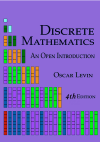Preface Preface
This text aims to introduce select topics in discrete mathematics at a level appropriate for first- or second-year undergraduate math and computer science majors, especially those who intend to teach middle and high school mathematics. The book began as a set of notes for the Discrete Mathematics course at the University of Northern Colorado. This course serves both as a survey of the topics in discrete math and as the “bridge” course for math majors, as UNC does not offer a separate “introduction to proofs” course. As this course has evolved to support our computer science major, so has the text. The current version of the book is intended to support inquiry-based teaching for understanding that is so crucial for future teachers, while also providing the necessary mathematical foundation and application-based motivation for computer science students. While teaching the course in Spring 2024 using an early version of this edition, I was pleasantly surprised by how many students reported that they, for the first time, saw how useful math could be in the “real world.” I hope that this experience can be replicated in other classes using this text.
This book is intended to be used in a class taught using problem-oriented or inquiry-based methods. Each section begins with a preview of the content that includes an open-ended Investigate! motivating question, as well as a structured preview activity. The preview activities are carefully scaffolded to provide an entry-point to the section’s topic and to prime students to engage deeply in the material. Depending on the pace of the class, I have found success assigning only the section preview before class, using the preview activity as in-class group work, or assigning the entire section to be read before class (each section concludes with a small set of reading questions that can be assigned to encourage students to actually read). For those readers using this book for self-study, the organization of the sections will hopefully mimic the style of a rich inquiry-based classroom.
The topics covered in this text were chosen to match the needs of the students I teach at UNC. The main areas of study are logic and proof, graph theory, combinatorics, and sequences. Induction is covered at the end of the chapter on sequences. Discrete structures are introduced “as needed”, but a more thorough treatment of sets and functions is included as a separate chapter, which can be studied independent of the other content. The final chapter covers two additional topics: generating functions and number theory.
While I believe this selection and order of topics is optimal, you should feel free to skip around to what interests you. There are occasionally examples and exercises that rely on earlier material, but I have tried to keep these to a minimum, and they usually can either be skipped or understood without too much additional study. If you are an instructor, you can also create a custom version by editing the PreTeXt source to fit your needs.
Improvements to the 4th Edition.
Many of the sections have been rewritten to improve the clarity of the exposition.
-
Nearly 300 new exercises, bringing the total to more than 750. These are better divided into preview activity questions, reading questions, practice problems, and additional exercises. Most of the new exercises are interactive for the online version.
-
New sections on probability, relations, and discrete structures and their proofs. Some other sections have been split up to make it more likely that a single class period can be devoted to a single topic.
-
Improved presentation for the counting chapter with a focus on considering sets of outcomes more than following rules.
-
The Investigate! activities of the 3rd Edition have been split into two types: Investigate! questions and Preview Activities. The former are open-ended questions designed to engage you with the topic soon to be discussed. The latter are structured preview activities that you should be able to completely answer before reading the section.
The previous editions (3rd Edition, released in 2019, 2nd Edition, released in 2016, and the Fall 2015 Edition) will still be available for instructors who wish to use those versions due to familiarity.
I plan to continue improving the book. Some of this will happen in real-time by updating the online versions to include new content (numbering will remain consistent). Thus I encourage you to send along any suggestions and comments as you have them.
University of Northern Colorado, 2024

